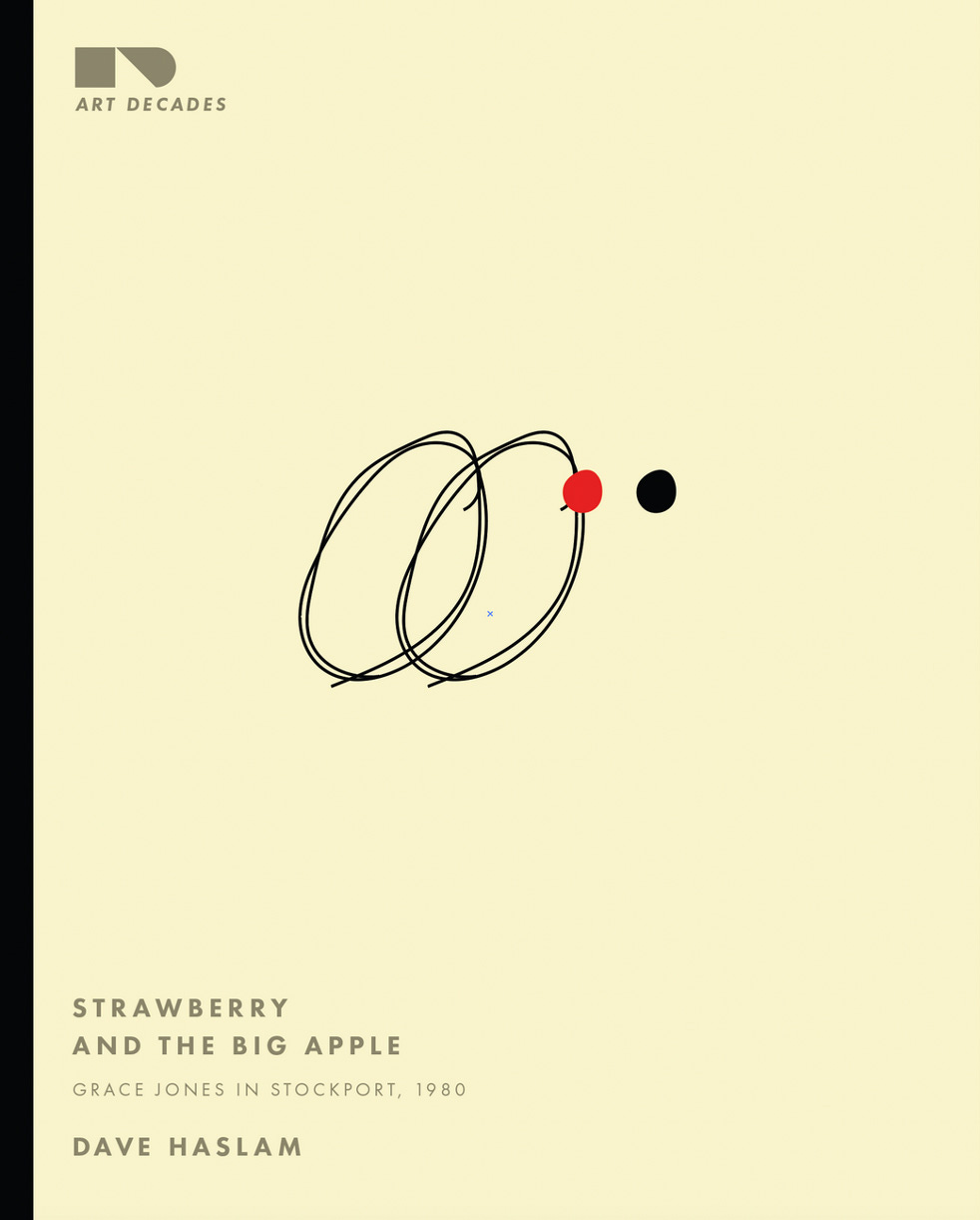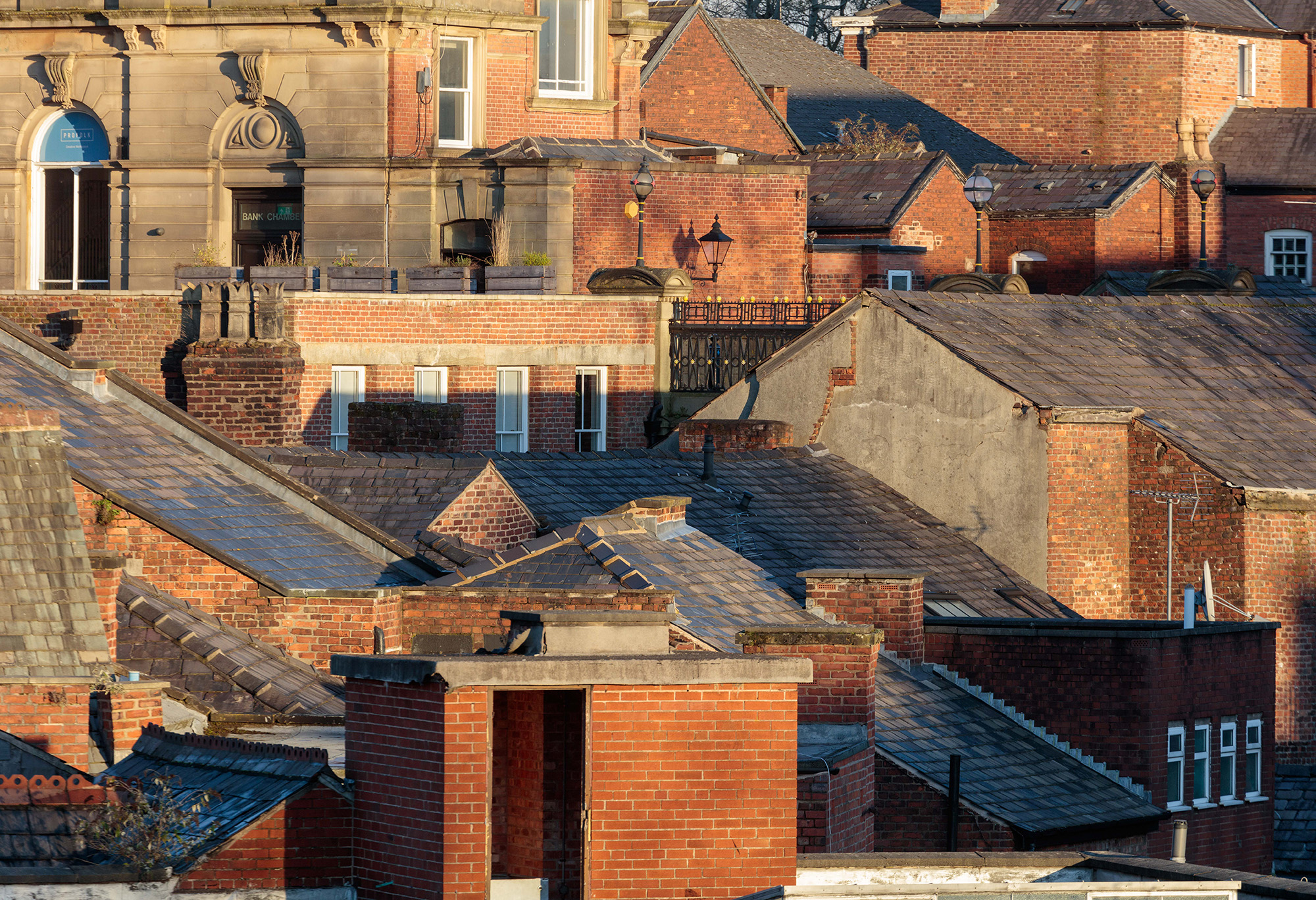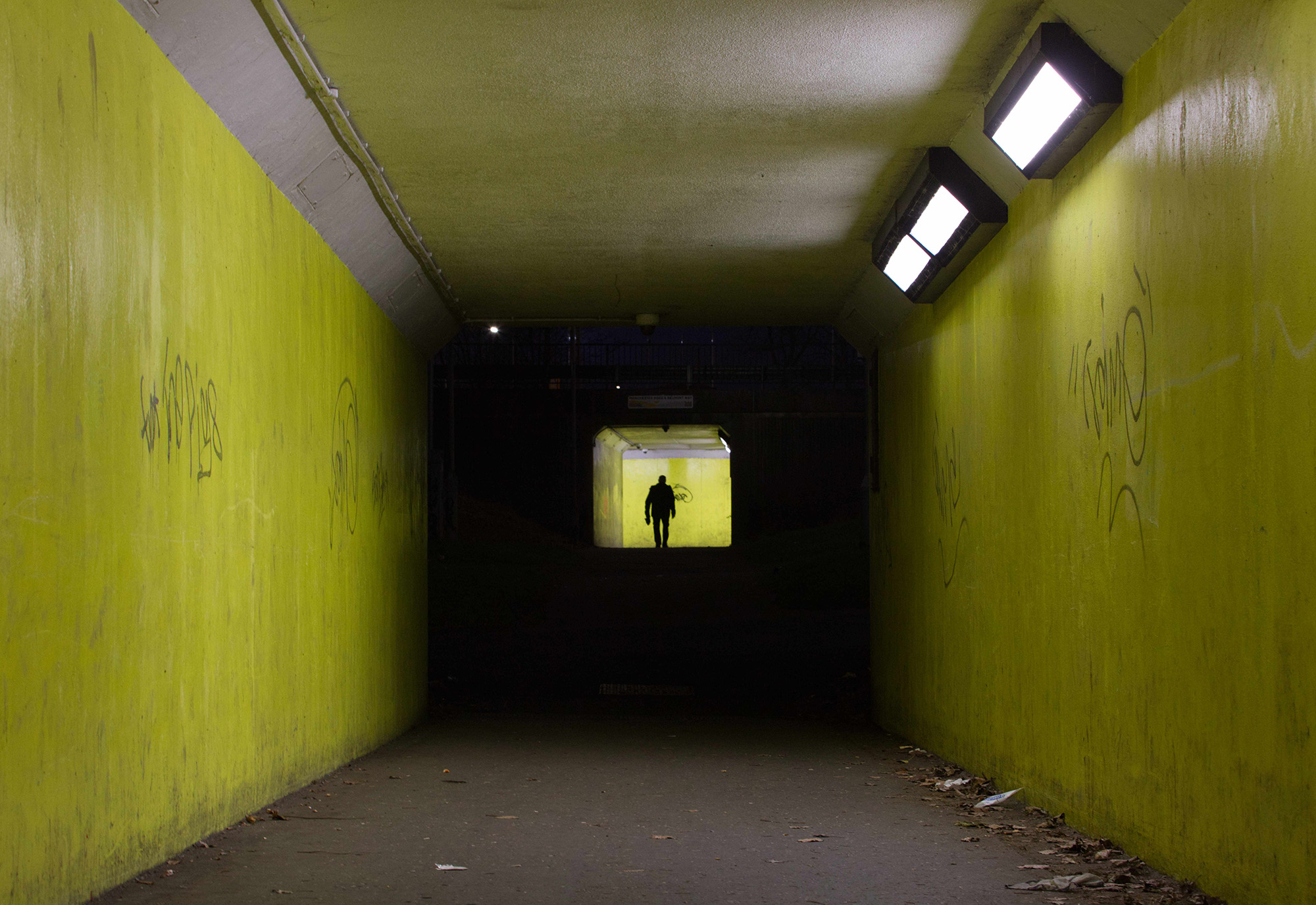Grace Jones in Stockport: Dave Haslam’s DJ-infused writing
on unexpected cultural histories
International DJ Dave Haslam has penned a short book centred on an unexpected visit of disco goddess Grace Jones to the town of Stockport in northern England. In telling the story of how this brief event came to be, Haslam explores interweaving anecdotes & narratives across cultural & spatial history, with a writing style honed in his DJing approach from the Hacienda & clubs worldwide. Illustrated with photographs by Paul Dobraszczyk.
Strawberry and the Big Apple: Grace Jones in Stockport isn’t really about the brief moment pop Goddess Grace Jones found
herself in Stockport. Sure, Dave Haslam’s book does hinge on the moment when the
unlikely event occurred – with wonderful recollections and details – but really
it is a study of the pop-cultural ecosystem across the post-industrial architecture
of Stockport. The larger regional cities of Manchester and Liverpool, both
rooted in British musical history, are pivotal to the story, but here Haslam
carefully explores the less-sexy and under-celebrated town of Stockport as a
critical part of modern cultural history.
![]()
![]()
![]()
Jones was primarily in the northwest of England for BBC interview with a disinterested Russell Harty – who she proceeded to slap live on air while hallucinating on bad cocaine (look for it on YouTube) – and another appearance on a Granada TV’s programme, both studios in Liverpool’s semi-abandoned dockside that Jones described in the NME as having “a hint of the end of the world about it.” After the recording, Jones went on to Stockport to spend time with Mancunian post-punk band A Certain Ratio (ACR) in the town’s Strawberry studios:
“The pubs shut at ten thirty; this was 1980, in Stockport. One thing A Certain Ratio remember is that, on arrival, Grace Jones asked for some wine. It was virtually impossible to get wine at eleven o’clock at night in Stockport. However, two bottles of wine were purchased from a local Indian restaurant just before closing up.”
![]()
![]()
Haslam’s book meticulously weaves the local histories of the emerging cultural scene of Stockport, Manchester, and Liverpool with international tales of Jones’ journey from Jamaica through Syracuse, Philadelphia, into New York’s 1973 disco scene, and on to Paris. Haslam takes pleasure in the juxtapositions and clashes of setting between these vast cities and the streets of Stockport – the final paragraph of Jone’s transatlantic journey, a description of Paris’ Le Palace nightclub’s decadence in 1978 – “The coke laid on was tinted pink” Jones says – crashes into a different locale: “Stockport is a town seven miles south of Manchester, featuring what’s said to be the largest brick-built structure in northern Europe, the railway viaduct.”
While Jones is a recurring motif throughout Dave Haslam’s book, and Stockport emerges as the main protagonist, the text is more a tightly weaved poetical consideration of a wide set of histories around music, culture, situation, happenstance, politics, and urban change. It is a compression of anecdotes, facts, memories, and entwined narratives not thrown in just for colour, but carefully placed to forge an emerging sense of place and time. The various tales and recollections are not wasteful in their delivery. In a book of only 58 small pages, wide geographies, cultures, and histories are traversed without feeling too dense in its telling. This is due to Haslam’s writing style offering a clarity and brevity that offers enough of each tale to present the key details with wit and sense of occasion, but also leaving the reader with a real sense of wide-eyed ‘I want to know more!’ in the process.
Haslam has not always been a writer, and though he now has a growing catalogue of creative non-fiction, he is still perhaps most well known as a DJ who honed his craft from the mid 1980s playing over 450 times at the Hacienda nightclub – an iconic venue now converted into luxury apartments, but aesthetically and symbollically referenced in Manchester’s new Aviva Studios (see 00147). Having played alongside, before, and after bands such as the Stone Roses, New Order, and Depeche Mode, he has travelled the world playing a singularly eclectic, clashing mix of records.
![]()
![]()
There are perhaps parallels between Haslam’s DJing and writing. A DJ needs to understand and play with countless musical histories and recordings, extracting from them motifs, beats, or refrains to create new relationships and soundscapes. As with the stories Haslam has selected and laid out in Strawberry and the Big Apple: Grace Jones in Stockport, these extracts need to be neat, concise, and have a clarity, and be played against each other with a playful sense of texture and interplay. In his writing, Haslam is evidently also playing with beats and rhythms.
A DJ overlaps and compresses material, changing speeds to create uncanny connections or dropping the needle momentarily into the middle of a vinyl just in the right place to add a moment of something unexpected to the larger piece. This is also how Haslam writes, dropping in tightly constructed beats of social and spatial history, leaving the reader constantly questioning where one narrative connects to another, or being taken on a sequential journey of mixes where tales segue from Stockport to New York, from Robert De Niro’s loft apartment to the Hacienda.
![]()
![]()
Throughout it all, there is a subtle entwining of architectural place and musical histories. The built landscape of Stockport is given as much respect and interest as New York’s Studio 54 or Paris’ Danceteria club – where an ACR gig was supported by Madonna’s first live performance. Through countless anecdotal descriptions – for example, that Stockport clothes shop Crazy Face was co-owned by the manager of The Smiths and could be found next door to a hairdresser who would go on to manage the Stone Roses – provides the cultural layering within which the main story of Grace Jones at the town’s Strawberry studios finds roots. And it’s a rich layering.
Strawberry and the Big Apple: Grace Jones in Stockport is part of an eight-book Art Decades series published by Manchester based Cōnfingō Publishing. The other books explore subjects including Picasso in Paris’ nightlife, LSD and the end of the 1960s, a Courtney love trip to Liverpool, and what Keith Haring got up to in the New York nighttime. Each can be bought individually, or as a limited-edition box set (details below). Within the eight short books are a multitude of tales and unexpected encounters that Haslam has intricately connected and contrasted to create a genuinely creative studies of historic moments in culture and place, just like that brief coming together of Grace Jones and Stockport.
![]()
![]()



figs.i-iii
Jones was primarily in the northwest of England for BBC interview with a disinterested Russell Harty – who she proceeded to slap live on air while hallucinating on bad cocaine (look for it on YouTube) – and another appearance on a Granada TV’s programme, both studios in Liverpool’s semi-abandoned dockside that Jones described in the NME as having “a hint of the end of the world about it.” After the recording, Jones went on to Stockport to spend time with Mancunian post-punk band A Certain Ratio (ACR) in the town’s Strawberry studios:
“The pubs shut at ten thirty; this was 1980, in Stockport. One thing A Certain Ratio remember is that, on arrival, Grace Jones asked for some wine. It was virtually impossible to get wine at eleven o’clock at night in Stockport. However, two bottles of wine were purchased from a local Indian restaurant just before closing up.”


figs.iv,v
Haslam’s book meticulously weaves the local histories of the emerging cultural scene of Stockport, Manchester, and Liverpool with international tales of Jones’ journey from Jamaica through Syracuse, Philadelphia, into New York’s 1973 disco scene, and on to Paris. Haslam takes pleasure in the juxtapositions and clashes of setting between these vast cities and the streets of Stockport – the final paragraph of Jone’s transatlantic journey, a description of Paris’ Le Palace nightclub’s decadence in 1978 – “The coke laid on was tinted pink” Jones says – crashes into a different locale: “Stockport is a town seven miles south of Manchester, featuring what’s said to be the largest brick-built structure in northern Europe, the railway viaduct.”
While Jones is a recurring motif throughout Dave Haslam’s book, and Stockport emerges as the main protagonist, the text is more a tightly weaved poetical consideration of a wide set of histories around music, culture, situation, happenstance, politics, and urban change. It is a compression of anecdotes, facts, memories, and entwined narratives not thrown in just for colour, but carefully placed to forge an emerging sense of place and time. The various tales and recollections are not wasteful in their delivery. In a book of only 58 small pages, wide geographies, cultures, and histories are traversed without feeling too dense in its telling. This is due to Haslam’s writing style offering a clarity and brevity that offers enough of each tale to present the key details with wit and sense of occasion, but also leaving the reader with a real sense of wide-eyed ‘I want to know more!’ in the process.
Haslam has not always been a writer, and though he now has a growing catalogue of creative non-fiction, he is still perhaps most well known as a DJ who honed his craft from the mid 1980s playing over 450 times at the Hacienda nightclub – an iconic venue now converted into luxury apartments, but aesthetically and symbollically referenced in Manchester’s new Aviva Studios (see 00147). Having played alongside, before, and after bands such as the Stone Roses, New Order, and Depeche Mode, he has travelled the world playing a singularly eclectic, clashing mix of records.


figs.vi,vii
There are perhaps parallels between Haslam’s DJing and writing. A DJ needs to understand and play with countless musical histories and recordings, extracting from them motifs, beats, or refrains to create new relationships and soundscapes. As with the stories Haslam has selected and laid out in Strawberry and the Big Apple: Grace Jones in Stockport, these extracts need to be neat, concise, and have a clarity, and be played against each other with a playful sense of texture and interplay. In his writing, Haslam is evidently also playing with beats and rhythms.
A DJ overlaps and compresses material, changing speeds to create uncanny connections or dropping the needle momentarily into the middle of a vinyl just in the right place to add a moment of something unexpected to the larger piece. This is also how Haslam writes, dropping in tightly constructed beats of social and spatial history, leaving the reader constantly questioning where one narrative connects to another, or being taken on a sequential journey of mixes where tales segue from Stockport to New York, from Robert De Niro’s loft apartment to the Hacienda.


figs.viii,ix
Throughout it all, there is a subtle entwining of architectural place and musical histories. The built landscape of Stockport is given as much respect and interest as New York’s Studio 54 or Paris’ Danceteria club – where an ACR gig was supported by Madonna’s first live performance. Through countless anecdotal descriptions – for example, that Stockport clothes shop Crazy Face was co-owned by the manager of The Smiths and could be found next door to a hairdresser who would go on to manage the Stone Roses – provides the cultural layering within which the main story of Grace Jones at the town’s Strawberry studios finds roots. And it’s a rich layering.
Strawberry and the Big Apple: Grace Jones in Stockport is part of an eight-book Art Decades series published by Manchester based Cōnfingō Publishing. The other books explore subjects including Picasso in Paris’ nightlife, LSD and the end of the 1960s, a Courtney love trip to Liverpool, and what Keith Haring got up to in the New York nighttime. Each can be bought individually, or as a limited-edition box set (details below). Within the eight short books are a multitude of tales and unexpected encounters that Haslam has intricately connected and contrasted to create a genuinely creative studies of historic moments in culture and place, just like that brief coming together of Grace Jones and Stockport.


figs.x,xi
Dave Haslam grew up in Birmingham and moved to Manchester in
1980 and attended the University of Manchester where he studied English
Literature. In 1983 he founded Debris, a post-punk fanzine. In 1985 he
was invited to contribute to NME and his journalism has subsequently appeared
in The Face, The New Statesman, The Guardian & The London Review of Books.
He attended Joy Division’s last ever show back in May 1980;
since then, Sonic Youth have slept on his floor; Tony Wilson threatened to
shoot him; he took John Peel to see Public Enemy; he’s cooked cauliflower
cheese for Morrissey; Neil Tennant introduced him to Tracey Emin; and he
appeared in the film 24 Hour Party People and in Carol Morley’s The Alcohol
Years.
Haslam is a former resident DJ at the legendary Hacienda
club in Manchester, making his debut in 1986 & going on to a career playing
globally. Since the early 1990s he has hosted a variety of successful club
nights in Manchester, including ‘Yellow’ at the Boardwalk. He’s played
afterparties for New Order, Gorillaz, and Depeche Mode. His recent DJ gigs also
include a performance at Panorama Bar (Berghain) in Berlin and a headline set
at the Electropicales Festival, Île de
la Réunion.
He has written five full-length books, including Manchester,
England – a cultural biography of Manchester which was declared one of the ten
books that best represent England (alongside works by Jeremy Paxman, Zadie
Smith, and George Monbiot). His journalism has appeared in NME, The Times,
Guardian, London Review of Books and New Statesman.
His latest project, Art Decades, published by Manchester
based Cōnfingō Publishing, is a highly original and wide-ranging series of eight
small-format books exploring a variety of subjects rooted in cities, in recent
history and lived experience, and a love for music, literature, and art.
www.davehaslam.com
purchase
Dave Haslam’s Strawberry and the Big Apple: Grace Jones in Stockport is available from Cōnfingō Publishing at
www.confingopublishing.uk/product-page/strawberry-and-the-big-apple-grace-jones-in-stockport-1980-dave-haslam
The complete Art Decades box set, containing all eight books by Dave Haslam, is available at:
www.confingopublishing.uk/product-page/art-decades-the-complete-box-set-by-dave-haslam
images
fisg.i,ii,x,xi Images of Dave Haslam and Art Decades books courtey of Dave Haslam and Cōnfingō Publishing.
fig.iii PALIMPSEST - Old Stockport from the Merseyway car park. ©
Paul Dobraszczyk.
fig.iv PATINA - Enterprise Mural, 89 Lower Hillgate, Stockport Keith Ormondroyd, 1983. © Paul Dobraszczyk.
fig.v INDUSTRIAL - London and North Western Railway Company's Goods Warehouse, Wellington Road North, Stockport, 1877. © Paul Dobraszczyk.
fig.vi RESIDUE - Building on Wellington Street South. © Paul Dobraszczyk.
fig.vii CORNER - Lancashire Hill underpass. © Paul Dobraszczyk.
fig.viii CORNER - Army Reserve Centre, Greek St, Edgeley, Stockport, 1862.
© Paul Dobraszczyk.
fig.ix GHOST - Stockport Air-raid shelters, Chestergate.
© Paul Dobraszczyk.
publication date
03 June 2024
tags
A Certain Ratio, Aviva Studios, Confingo Publishing, Paul Dobraszczyk, Hacienda, Dave Haslam, DJ, Russell Harty, Grace Jones, Liverpool, Madonna, Manchester, New York, Paris, Stockport, Writing
www.confingopublishing.uk/product-page/strawberry-and-the-big-apple-grace-jones-in-stockport-1980-dave-haslam
The complete Art Decades box set, containing all eight books by Dave Haslam, is available at:
www.confingopublishing.uk/product-page/art-decades-the-complete-box-set-by-dave-haslam


